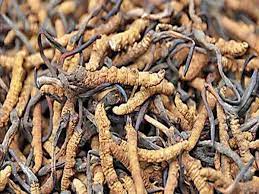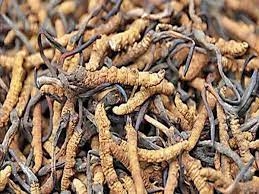
Production of Medicinal Mushroom BY ( keeda jadi) Dr.Hemendra Yadav
Medicinal mushrooms are valuable sources of food and traditionalmedicine and are being used as alternative of medicines. They are rich sources of various bioactive components which have many healthbenefits. Cordyceps-M mushrooms is also medical mushroom.Himalayan Viagra, Yarsagumba, Caterpillar Fungus, Keeda Jadi, etc have many name of Cordyceps-Mmushrooms.There are around 400 differen species of Cordyceps, but those most commonly used in medicine tend to be Cordyceps Sinesis and Cordyceps Militaris.According to many studies cordyceps mushrooms(Keeda Jadi )reduce fatigue and increase the body's stamina. It increases muscle strength by increasing ATP levels and antioxidant enzyme activity. It also reduces lactic acid levels in muscles. Several researches have also demonstrated that this mushroom(Keeda Jadi) increases glucose from the muscle by activating the pathways that control the muscles. In addition, this mushroom(Keeda Jadi) increases ATP energy molecules and removes free radicals by increasing the body's antioxidant defense. This mushroom (Keeda jadi) also increases insulin availability in blood and liver glycogen levels. It increases the efficiency of the heart during exercise by increasing blood flow and testosterone levels. Thus it reduces fatigue and increases the strength of the body.Due to its widespread applications in cancer prevention and treatment, public interest in complementary and alternative medicine has increasedworldwide.Cancer is a global challenge for human health. Cordycepine found incordyceps(Keeda Jadi) has emerged as a strong anticancer agent in many ways. Several studies suggest that cordycepin induces apoptosis of human cancer cells. According to several researches cordycepsin has been widely used as an antitumor agent, with anti-metastatic and antiproliferative effects found to induce apoptosis. Cordycepin regulates the signaling pathway related to tumor development and metastasis. Therefore cordyceps(Keeda Jadi) may be beneficial for the development of anticancer drugs that target tumors. Cordyceps sinensis Cordyceps(Keeda Jadi) is a genus of Ascomycetes fungi that includes about 400 species. Most of these grow on insects. C.sinensis is the most important species due to its medicinal properties and
Medicinal mushrooms are valuable sources of food and traditional it is found in higher reaches of Himalaya (Nepal, Bhutan and Tibet as well as the bordering areas of India and China) at a height of 3000 to 5500 meter. The medicinal properties are attributed to Cordycepin and some polysaccharides. It is regularly collected from high reaches. When snow starts to melt in May to July, you can see many collectors going in search of this mushroom(Keeda Jadi). Commonly it is called Kira ghas (in India) or Yartsa gunbu/ Yarsagumba in Tibet). In India it is found in Pithoragarh region of Utrakhand. Collectors pluck mushroom (Keeda jadi) before it can mature and scatter its spores which is resulting in destruction of this Himalayan goldmine. Now we know that C. sinensis parasitizes ghost moth larvae. This fungus can grow on many artificial substrates. Also, ghost moth larvae have been successfully reared. Its cultivation was achieved in China in 2013. Large scale artificial cultivation has been recently achieved and 10 ton of this mushroom(Keeda Jadi) was cultivated in China in 2016. It can be cultured in liquid medium containing 1.25% glucose, 1.25% sucrose, 0.02% peptone, 0.0625% yeast powder, 0.025% KH2PO4, 0.0125% MgSO4.7H2O, 0.0025% Vit B1 and natural pH at 24 °C. Based on DNA analysis, it was found to differ from other
Cordyceps species(Keeda Jadi) and has now been renamed as Ophiocordyceps sinensis.
Lab and Culture preparatio
C. militaris(Keeda Jadi ) is cultivated under lab conditions where facilities for control of temperature, humidity and filtered fresh air are available. Cultivation is done in Jars kept on racks just like we keep bags or bottles in a spawn lab. It is cultivated at 16- 24°C and requires 800-1000 lux light for its fruiting. During cultivation relative humidity needed is 70-80%. Potato Dextrose Agar (PDA) medium is used for maintaining and multiplication of the culture. To make PDA, take about 250 g potato, peal
these and dice into small pieces. Put 200 g diced potatoes in one litre distilled water and boil for 15- 20 minutes or till potatoes become semi-soft. Sieve it and to clear solution add 20 g dextrose and 14 g agar. Boil it, pour in test tubes, autoclave and prepare slants. Pure culture of this mushroom(Keeda Jadi) can be procured from outside or made from fruitbody using tissue culture method described in chapter of spawn (clean fruit body, cut into two parts and from upper part in the middle take small
tissue and put it in test tube). Cultures are kept in dark for 8-10 days for spread of mycelium. Mycelium will be of pure white in colour due to its growth in dark. When kept in light it turns orange in 4-5 days. We can also multiply the culture in Petri plates for its use for preparation of liquid culture. Liquid Spawn To begin with, mycelium is cultured on a liquid
medium. For preparation of liquid spawn liquid medium is prepared using glucose 30 g, peptone 10 g, yeast extract 5 g, KH2PO4 1 g, MgSO4 0.5 g per litre of distilled water. The medium is poured in flasks, autoclaved,cooled and culture from the test tubes is transferred to sterilized liquid medium and kept on shaker for 4-5 days for preparation of liquid spawn.
It may be possible to make liquid spawn on Potato broth, that is same medium as used for multiplying cultures but without adding agar-agar.
Keeda Jadi Lab
Substrate Preparation
First step in preparation of the substrate is the preparation of nutrient solution. For this we add the following in 1000 ml distilled water.
Glucose 20 g
Peptone 5 g
Yeast extract 3 g
KH2PO4 2 g
MgSO4 0.5 g
Tri Ammonium Citrate (TCA) 1 g
Vit B1 50 mg
Vit B12 10 mg
Multivitamin 10 mg
There are other formulations for preparation of nutrient medium wherein the quantity of above ingredients may vary and potato extract, silkworm larvae powder or herbal eggs may be added along with other ingredients like glucose, peptone, MgSO4, yeast extract, Vit B1, etc. Vit B1 is an important ingredient in all combinations (when eggs are added then after mixing in blender, the foam from the top can be removed).Second step is the supplementation of brown rice with above nutrient medium. Brown rice is soaked in water for 30 minutes, cleaned and washed thoroughly. Thereafter, it is kept on a sieve or cotton cloth and
allowed to dry for 30 minutes (various workers have used substrates other,than rice also for the cultivation of this mushroom(keeda jadi). Take 20-25 g rice per jar, add about 40 ml nutrient solution to it and cover the jar with autoclavable cap or polypropylene bag and autoclave at 15 psi for 40-50 minutes. A small hole is made in the cap and it is plugged with cotton. This is sufficient for aeration required during,growth. We cool the jars and add 5-10 ml liquid spawn. Whole operation
is done in Laminar Flow cabinet to ensure that there is no contamination. Jars are moved left to to right to spread the liquid medium ovr the solid medium. Cultivation After inoculation with liquid spawn the jars are kept in dark for 8-10 days at 20- 22°C, RH 65-70%. Jars can be covered with dark,polythene or cloth to create dark conditions. Mycelium spreads in the
medium and because of its growth in dark, it is of white colour. After,complete colonization of the substrate, the jars are kept in light for a week when the colour of mycelium turns orange. Thereafter we provide 1000 lux light for 12 hours daily. It may take 7 days for yellowing, another 2 weeks for bubble and then pinheads formation. When distinct pinheads are formed we can reduce the light to 8-12 hours and it may take another 5-6 week till mushrooms(Keeda jadi) attain harvestable size of 4-6 cm. It can take up to 72 days after we expose the colonize substrate and the total time required for one crop from inoculation to harvest can be up to 3,months. Fresh air may be needed at regular intervals to avoid high carbon dioxide build up in the incubation room. When head of mushroom(Keeda Jadi) turns club shaped, it is ready for harvest .The mushrooms(Keeda Jadi) are plucked out of jars and dried. It can be sold as such or used for making different types of neutraceuticals/ supplements.
Cordycepin(Keeda Jadi) is an important ingredient and cultural conditions affect the production of cordycepin(Keeda Jadi).
For More Information About Keeda Jadi Growing Chamber Contact Awotech India.





